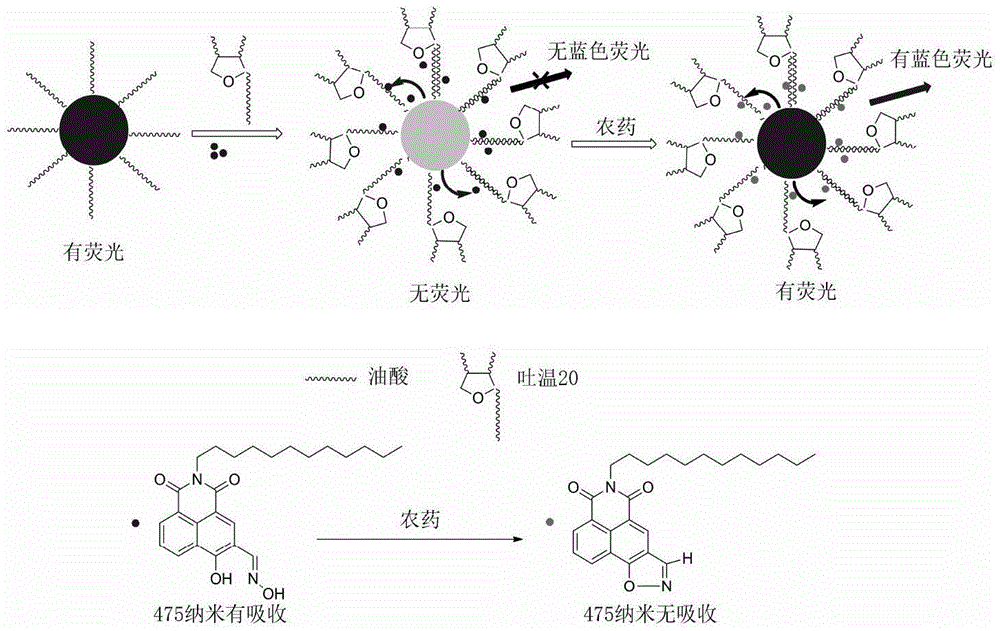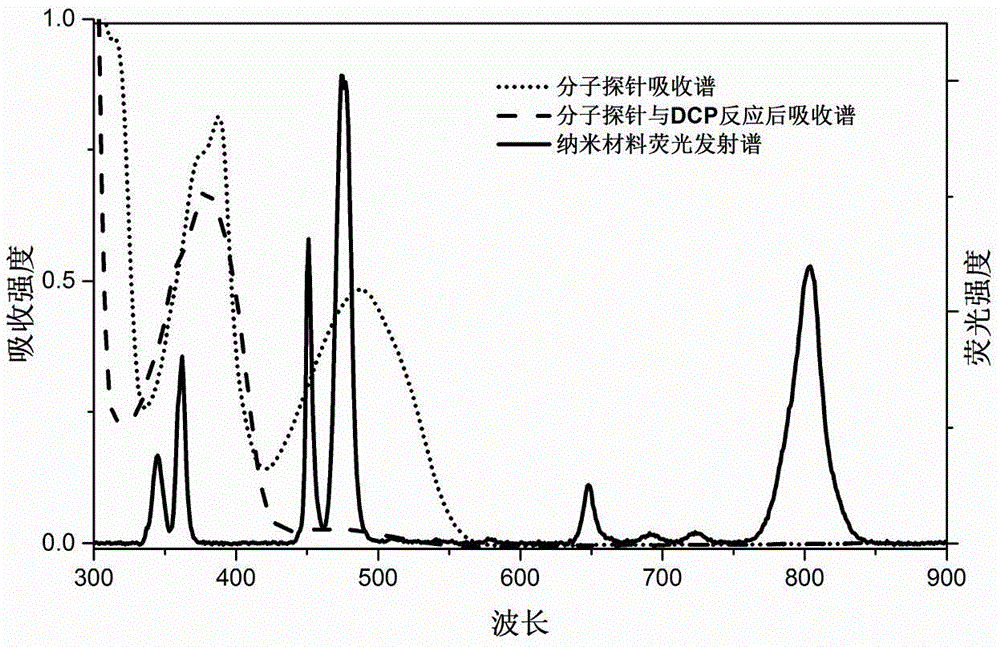Organophosphorus pesticide molecular probe, preparation and application method thereof and inorganic/organic composite rare earth upconversion nano material
A rare earth upconversion, organophosphorus pesticide technology, applied in the field of pesticide detection, can solve problems such as limited wide application, photobleaching stability of molecular probes, etc.
- Summary
- Abstract
- Description
- Claims
- Application Information
AI Technical Summary
Problems solved by technology
Method used
Image
Examples
Embodiment 1
[0063] NaYF with blue fluorescence 4 :20%Yb,0.1%TmNaYF 4 The preparation of core-shell structure rare earth up-conversion nanoparticles is as follows:
[0064]Accurately weigh yttrium chloride (156.0mg, 0.8mmol), ytterbium chloride (56.0mg, 0.2mmol), and thulium chloride (0.3mg, 0.001mmol) into a 100mL three-necked bottle, then add 7mL oleic acid, 15mL1 -Octadecene, vacuumize at room temperature for 10min; gradually raise the temperature to 160°C, stir for 40min; cool the system to room temperature, transfer it to a 48°C water bath, and then add pre-prepared ammonium fluoride (148mg, 4mmol, 5mL methanol) , sodium hydroxide (100mg, 2.5mmol, 5mL methanol) mixed solution, stirred in a water bath for 40min; then moved the system into a heating mantle, raised the temperature to 75°C, pumped air to remove methanol, then gradually raised the temperature to 300°C, and kept stirring for 1.5h After the end, the system was naturally cooled to room temperature, moved into a 50mL centrif...
Embodiment 2
[0068] The preparation of the core-shell structure nanomaterial modified by Tween 20, its method is as follows:
[0069] Take 20 mg of oleic acid-modified core-shell structure rare earth nanomaterials in a round bottom flask, add 10 mL of cyclohexane, and ultrasonically disperse; add 100 μL of Tween 20, ultrasonically for 15 min, and stir at room temperature for 1 h; slowly drop into 25 mL of ultrapure In water, stir and volatilize cyclohexane at 70°C until the solution is clear; cool at room temperature, centrifuge, and wash with ultrapure water for 3 times, and the solid obtained by centrifugation is dispersed in ultrapure water to obtain the surface Tween 20-modified rare earth upconversion nano particles. Its TEM characterization as figure 2 As shown in b, after water-soluble modification with Tween 20, the particle size and morphology of nanomaterials did not change significantly.
Embodiment 3
[0071] The preparation of inorganic / organic composite rare earth up-conversion nanomaterials, the specific synthesis steps are as follows:
[0072] Weigh 20 mg of Tween 20-modified core-shell structure rare earth nanomaterials, disperse them in 5 mL of N,N-dimethylformamide, then weigh 30 mg of molecular probes and add them, sonicate for 10 min, and then disperse them at room temperature. Stir overnight. Afterwards, the precipitate was collected by centrifugation, washed twice with water, and then the solid was dried to obtain a rare earth nanomaterial loaded with molecular probes. The characterization of its spectroscopic properties is as follows image 3 As shown, the rare earth nanomaterials have strong emission at 475nm and 803nm, and the molecular probe has strong absorption at 475nm, but after reacting with diethyl chlorophosphate, the ultraviolet absorption of the molecular probe at 475nm is sharp reduce.
PUM
| Property | Measurement | Unit |
|---|---|---|
| particle diameter | aaaaa | aaaaa |
| particle diameter | aaaaa | aaaaa |
Abstract
Description
Claims
Application Information
 Login to View More
Login to View More - R&D
- Intellectual Property
- Life Sciences
- Materials
- Tech Scout
- Unparalleled Data Quality
- Higher Quality Content
- 60% Fewer Hallucinations
Browse by: Latest US Patents, China's latest patents, Technical Efficacy Thesaurus, Application Domain, Technology Topic, Popular Technical Reports.
© 2025 PatSnap. All rights reserved.Legal|Privacy policy|Modern Slavery Act Transparency Statement|Sitemap|About US| Contact US: help@patsnap.com



